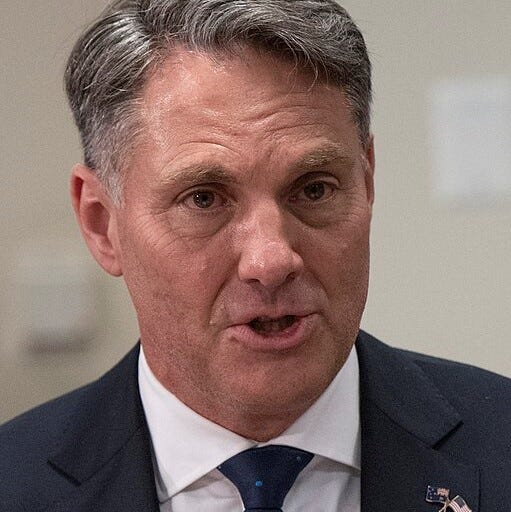Richard Marles and the ‘seamless’ transfer of Australian sovereignty
Deputy PM wants to 'break down the barriers' of defence export controls to create ‘seamless’ trilateral industrial base under AUKUS
Speaking at the American Chamber of Commerce on Wednesday, deputy prime minister and defence minister Richard Marles opened with an anecdote praising a former PricewaterhouseCoopers partner. It was an interesting choice given the tax leaks scandal engulfing PwC, which is making headlines globally, and last week forced the resignation of its Australian CEO.
But Marles was amongst friends. ‘I’m thrilled to be among so many great American companies contributing to Australia.’ He said the Defence Strategic Review had recommended the Defence Department become ‘a better customer’ to defence industry by adopting a new approach to acquisition. Furthermore, ‘the intimate relationship between the US and Australia at a government level implies an opportunity for the private sectors of both our countries.’ Christopher Pyne, yet again present with Marles, was approving.

In his speech, Marles talked about creating a ‘seamless’ defence industrial base between Australia, the United States and the United Kingdom. This will match the ‘seamless’ interoperability of Australian and US military forces, to be enabled by changes to Australia’s defence laws.
There are many national and international laws and treaties regulating defence industry and its exports, which get in the way of ‘seamless’. (Certain US senators want to TORPEDO them.) Marles sees these regulations as ‘barriers’ that need ‘breaking down’ to facilitate AUKUS.
He set the scene for his speech by delivering his oft-used lines:
We are seeing the biggest conventional military build-up in the world since the end of World War Two. And it is happening right here in our region.
Some rarely-reported facts are necessary for context when considering that claim.
Global military expenditure in 2022 was $2.24 trillion. Of that, the United States accounted for $877 billion (39%). China was second, spending $292 billion (13%) and Russia third, $86.4 billion (3.9%). (All US$.) The US outspent the next ten countries combined.
The US also dominates the world in major arms exports. For the period 2018-22, the five largest weapons exporters were the USA (40%), Russia (16%), France (11%), China (5.2%) and Germany (4.2%), who together accounted for three-quarters of all exports. Countries in North America and Europe accounted for 87% of all arms exports.
In Australia, there is remarkably little hard data on our defence industry. Australian Defence Magazine’s annual top 40 defence contractor listing provides the only snapshot.
The defence industry in Australia is dominated by some of the world’s largest multinational arms manufacturers: BAE Systems (UK), Thales (France), Boeing (US), Lockheed Martin (US), Rheinmetall (Germany) and Airbus (Europe). For four of the past five years BAE Systems has been the top contractor and Thales has been second. Boeing has been in the top five each time.
In 2017, an analysis by the Australian Strategic Policy Institute (which also used ADM Top 40 data) showed that over the 20 years from 1995-2015, the largest five firms in any given year accounted for, on average, about 65% of total revenue of arms-related contractors. In a chart for 2015, the top 10 took 82% of the revenue and 91% of revenue went to the top 15, leaving less than 10% for the rest, which is where almost all Australian-owned arms companies exist. Updated research is desperately needed, particularly given the significant sums now flowing into this industry.
On the over-hyped subject of jobs, ASPI’s briefing provided useful data: ‘Defence industry accounts for 0.23% of jobs in Australia, and 2.9% of jobs in the manufacturing sector. In terms of annual revenue, defence industry accounts for 0.22% of Australian industry and 1.7% of the manufacturing sector. So, although Australian defence industry is undoubtedly important for our defence force, it represents only a trifling fraction of the overall Australian economy.’ Again, updated research is needed.
In his speech, Marles said the government’s injection of $3.4 billion into a new Advanced Strategic Capabilities Accelerator will ‘help us start delivering advanced, asymmetric capabilities that benefit not just Australia but the US and the UK. And it will start to build a truly trilateral industrial base across our three countries that will see us more seamlessly transfer the skills, workers, and intellectual property we need.’ Australian taxpayers will support the US and UK industries. Why?
He also spoke of ‘breaking down the barriers’ of export controls to facilitate AUKUS.
While there is a shared mission between our countries and an agreement at the highest levels of our governments, there are significant barriers we must break down across our systems… This is particularly true of our export control regimes.
Regulations around transfers of technology, sensitive information and defence materiel are, of course, understandable.
The lip service to regulations being ‘understandable’ was immediately followed by:
But what is really clear is that if we are to realise the ambition of AUKUS, the transfer of technology and information between Australia and the US needs to be seamless…
Australia is committed to breaking down these barriers in our own system while maintaining the robust regulatory and legal frameworks to protect these transfers.
The defence minister did not explain how regulatory control could be broken down while concurrently maintaining a robust regulatory framework.
Australia’s defence industry is already dominated by multinational US and UK arms corporations. Local industry (including local subsidiaries of global giants) has been historically lucky if it gained one third of defence acquisition spend, the remainder heading offshore.
If the government removes most of the regulation and creates a ‘seamless’ trilateral industrial base, it is hard to see how anything other than even greater flows offshore to the multinationals will eventuate, despite the political spin.
This article was also published at John Menadue’s Pearls & Irritations on 18.5.23


